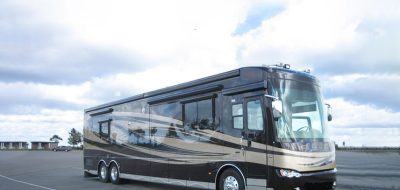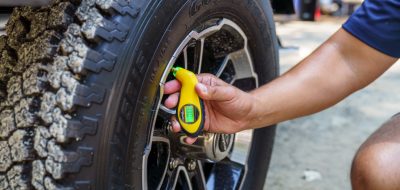What do your eyes tell you. Take the RV tire test and post your answer in the comments section. One tire is inflated to 45.5 psi and the other is inflated to 65.5 psi. Is tire A or tire B inflated to 65.5 PSI? I’ll post the answer in the comments section on 02/20/09. (SEE ANSWER BELOW)
RV Tire A RV Tire B
I have always been an advocate for RV tire care and maintenance. Recently I received an e-mail from Roger Marble who is a retired tire design quality engineer with 39 plus years experience. Roger now gives tire seminars at RV events. He e-mailed me these two pictures of an RV tire. In one picture the tire is inflated to 65.5 PSI and in the other the tire is inflated to 45.5 PSI. Roger challenged me to pick which tire was which. Of course I had a 50% chance of being right or wrong, but the point was you cannot determine the tire pressure by looking at the tires. There can be as much as 20 PSI difference between tires that look the same.
I am sure you have heard the expression “where the rubber meets the road.” The tires are the most vulnerable component on your RV. They are subject to abuse from road conditions, overloading, under-inflation, over-inflation and often time’s plain old neglect from the RV owner. We all tend to take tires for granted. You know what I mean, when was the last time you checked the inflation pressure in your tires? Especially the inner duals if you have a motor home. Better yet, when was the last time you had your RV weighed?
Two of the biggest problems are overloading and under-inflation. Overweight RVs and under inflated tires are both unsafe, send operating and repair costs sky high and can cause unexpected downtime. Failure to maintain the correct tire pressure can result in fast tread wear, uneven wear, poor handling, and excessive heat, which can lead to early tire failure. When a tire fails many RVers contribute it to a defect in the tire, but that is rarely the case.
Overloading the tires on your RV is probably the number one leading cause of tire failure. Poor weight distribution and taking advantage of all of the storage space offered on today’s RV’s result in tire overloads. The only way to find out is to have the fully loaded vehicle weighed on platform scales. Load the vehicle with everything you plan to take on a trip including passengers, cargo, fuel, full fresh water and propane tanks. If you tow something behind the RV take it to the scales with you. The problem is that it is quite possible to weigh the RV and not exceed the GVWR, GAWR or GCWR, but you could be exceeding the individual tire ratings. This is why you MUST weigh each axle end separately to determine if tire ratings are exceeded and if the loaded weight is properly distributed.
Another leading cause of tire failure is under inflated tires. The load rating for a tire is only accurate if the tire is properly inflated for the load. An underinflated tire can’t carry the load of a properly inflated tire and the extra weight causes greater heat buildup in the tire, which can lead to tire failure. The appearance of the tire can look normal but the internal damage is not visible and the tire can fail at any time without warning. If you find any tire 20% or more below the correct inflation pressure have it removed, demounted and inspected. Driving on a tire that is 20% or more under inflated can cause serious, permanent damage to the tire that may not be visible to the eye.
Tires can lose up to two pounds of air pressure per month. If you don’t check your tires for three or four months they could be seriously under inflated. Ideally you should check tire inflation, and adjust it if required, everyday that you move or drive your RV. If you can’t get into the habit of doing it on a daily basis you need to make it a point to check all tires weekly at a minimum when you’re traveling. You always want to check the tires when they are cold, meaning that you don’t drive or move the RV before checking inflation pressure. If you check the inflation pressure when the tires are hot you will get a higher pressure reading and if you let some air out they’ll be under inflated when they are cold.
If you have dual wheels you’ll want to add extension hoses to the valve stems to make the job of checking tire inflation easier. It can be nearly impossible to check the inner dual without extension hoses. The best extension hoses will have stainless steel reinforcement and external braiding for long trouble-free life. Make sure the ends of the hoses are securely attached to the wheels. If you add extension hoses you should replace the rubber valve stems with all steel valve stems. The added weight of the extension hoses can cause rubber stems to leak air resulting in under inflation.
The only way to correctly measure the inflation pressure in your tires is with a quality inflation pressure gauge. Using your boot or a Billie club is not a quality pressure gauge, and don’t ever depend on your eyes to check tire inflation. There can be as much as 20 PSI difference between tires that look the same. You need to invest in an accurate inflation pressure gauge. You should get one with a double, angled foot. This makes it much easier to check the outer tire of a dual set.
The correct answer is Tire A
Mark Polk








Mark Polk
Arlene,
Proper tire pressure depends on several factors. A few, but not all of these factors are the size of the tire, the type of tire it is, the weight of the trailer and perhaps most important the overall load placed on the tire.
The only way to truly know the load on the tires is to have each tire position of the fully loaded trailer weighed individually. The inflation pressure on the sidewall of the tire is the pressure required if a full load were on the tire.
If you replaced the tires with the same size and type that were originally on the trailer look for the tire manufacturer recommended inflation pressures on a placard on the trailer or in the tire manual that came with the trailers owner manual.
If you don’t have or can’t find this information do a search on the internet for the tire manufacturers tire load & inflation tables for the type and size tires they are.
Pingback: Is your Tire Pressure Gauge Accurate?
Arlene Sullivan
When buying new tires the other day for our tt, the tech told us to keep the pressure 10 under what the tire rating says. Is this correct??
Jr
I guessed tire A and was correct…Maybe luck !!! I have found, keeping records of every tire every three (3) months have paid off. I check tire pressure and depth then check against previous recordings this also will let you know if you have a bad seal, tie rod end, bearings, brake line’s, etc…
What i did not know and have learned from the article, was to use steel stem’s vs rubber stem’s when adding valve extensions…I don’t know why that was not obvious to me….
But as always, Thanks Mark…….
Jr
Roger
To all
1. Thanks for taking the Quiz.
2. I hope we all learned and confirmed that the ONLY way to properly check tire inflation is with a GOOD gauge
Just to answer some questions. Yes I have a digital gauge that reads to 0.5 psi and I have confirmed its accuracy by calibrating against Master gauges that are ISO certified and traceable to NIST standards.
BUT
You don’t need a gauge that accurate. Just get a Digital gauge and you will probably be +/- 2 psi or better. I have checked 10 different digital gauges and all were accurate to +/- 1 psi.
Checking your rig, just at the start of a trip will not catch punctures that happen during your travels. I strongly urge everyone to check before each time we move our RV from home or from a nights camping or have a Tire Pressure Monitor System installed. I feel so strongly about knowing my tires are properly inflated I have weighed my RV. Installed a TPMS and I still measure the tire inflation with a gauge each trip.
Happy RV’ing.
Roger.
Jim
first of all, I don’t believe there is a guage in common use that will read to accuracies of one-half pound. That said, I agree, that use of a tire pressure gauge is good practice, and maintaining tire pressure at tire mfg recommendations works best for tire life and road performance.
Mark Polk
HERE IS THE CORRECT ANSWER
I would like to thank everybody who participated. I think this is a good illustration demonstrating why you should always use a gauge rather than your eyes. And Mike makes a good point about the quality of the tire guage you use to check your tire pressure with. The gauge used for this demonstration was in fact calibrated and accurate to +/- 0.5 psi.
THE CORRECT ANSWER IS TIRE A IS INFLATED TO 65.5 PSI
Milo
my guess is ahhhhhhhhhhhhhhhhhhhhh tire B is 65.5….. really really can’t tell just lookin at em……that’s why god invented tire gauges so we wouldn’t have to guess …HUH!
Mike Downie
Great illustration – Another aspect of the same issue I’ve never seen discussed is tire gauge accuracy. I have a background in test equipment and calibration and can state that most stick gauges are only accurate to plus or minus 1 division AFTER they are calibrated. Before they are compared to a test standard that is at least four times as accurate, they could be off by many, many pounds. Using a calibrated one that reads within one pound I tested over 5 at a major discount store before finding one that matched it. Most were 3-5 pounds off. One was 15 pounds high! Shop around, cost is usually worth it!
Ila Rodgers
Use the guage – but will guess Tire A
DUCE
It appears that tire “a” has more sidewall bulge than tire B .
I use a guage to check tires. Thats way I know for sure what the pressure is.
Roger
Yes both pictures are of same tire. Only difference is 20 psi and I took the pictures without using a tripod.
This is easy.
You have been told the inflations not asked “What are the inflations?”
You are looking at the same tire not two different ones.
Light is almost identical.
DAN
i don’t have to guess anymore. i don’t have to run 100-105 psi for a cushion (just in case of a leak) anymore either. i don’t use the billy stick anymore either. i still use an infrared temp gauge to check brake caliper temperature at every stop. i now run 90-92 psi, the correct pressure for my moho’s weight.
i installed the TST TRUCK tire pressure AND temperature wireless sensor system.
my moho, on the workhorse chassis, has well known brake issues. they get hot and lock up randomly without warning. now, i will get a “HEADS UP” warning and alarm prior to damage occurring.
it seems that most of the time if you stop and let the brake (usually one at a time) involved cool off, you can continue driving normally. go figure…
nitza has had an investigation on this issue open for about a year and a half now.
another go figure…
clarke
The way I look at picture of tires were exposed from the sun which mean that they absorb heat – tires expanded (inflation). For some reason both pictures were taken the same tire but in a different angle?
Tom
Tire A is 65.5
joe zaremba
I’m guessing B
Bob Love
Did you just add 20# to the same tire? They both have the same stains and position, only the light and angle are slightly different. The comments on taking time to test the pressure are right on point!
G. Mueller
I really can’t the difference between the two. I check pressure before every trip.
If I find one tire much lower on pressure than the other three, it comes off and
goes to the service station for a suspected leak. I use a digital gage and also
carry a small compressor when traveling.
Ray Neenan
Its hard to say becuse I think the pictures of the tires are not at the same distance from the camera,that said I’ll guess and say it is B, it looks like its setting up higher to me.
John Shelton
I answered the question correctly in my mind before I continued to read the article. I saw no difference between the two tires and answered, “Impossible to tell”. Since I didn’t find the correct answer to select, I just proceeded to read the article. Good test of not only, “can you spot a low tire?’, but also of “are your eyes deceiving you?”
Bluebird Bob
Tire B….obviously
Bob
I say tire ( A ) has 65.5 lbs
Sid
It seems as if all articles on tire inflation focus on “Low Pressure” issues. How about one on “High Pressure” issues.
Rick
Why guess Use a tire gauge! Icheck my tires before each trip & look at them when we make a stop. I also carry a lasser thermometerto check tire temp.
Sue
I have my tires checked before each trip to assure that they are filled to the recommended 80 pounds pressure for each tire – tire rating from manufacturer. However, I bought my RV second hand and it didn’t have any manuals. Is there a way to find out what the weight rating is for each axle?
Michael Wader
To HAZARD a guess I say tire B. All the more reason to use a professional grade tire gauge.
Liz
tire A
Carlos Alvarez
Tire A , but I dont go by visual but by a gauge. I carry a small compressor with my rig and always check everytime I move it no problem until now with my tires. Ok my rig only has 18560 miles but it is a 2005. My tires look like new and also I keep them covered with tire covers at all times when stationed.
Liz
Tire A.
Kent
I think it is tire A
Drew
I say that B tire is the 65.5 lbs
Mark Polk
Mr Whit,
The whole point of this article (visual test) is to demonstrate that you cannot depend on your eyes to determine the amount of air pressure in your tires.
mr_whit
Mark, it is not safe to guess…use the gauge! I am not willing to chance my unit to lazyness-whit
Wayne Bowen
A